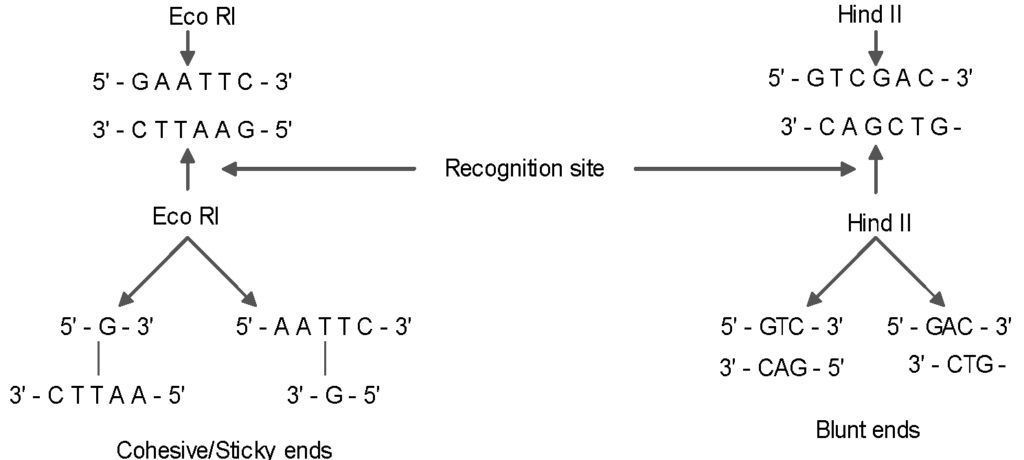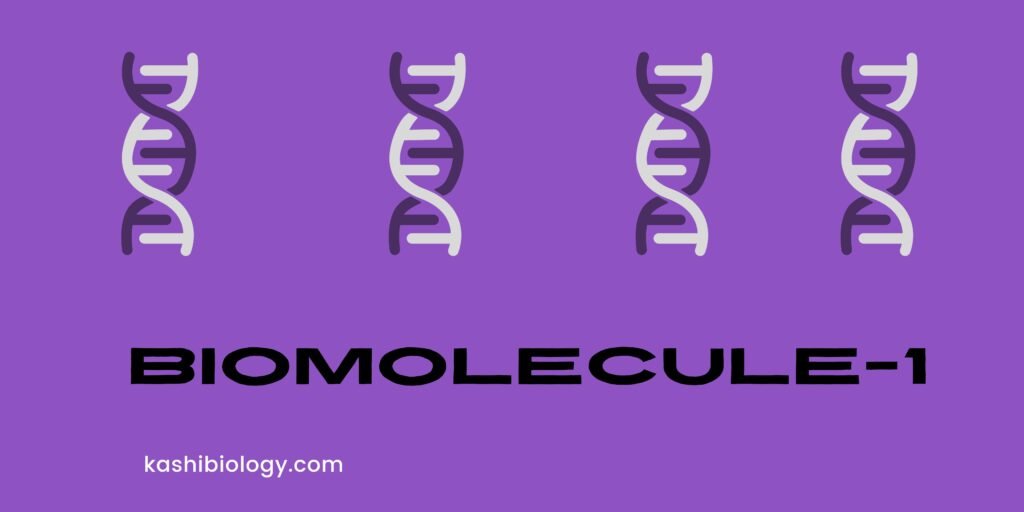Restriction Endonucleases – (R.E)
- First Restriction Enzyme – Hind II – (from Haemophilus influenzae)
- More than 900 Restriction enzymes discovered from over 230 strains (variety) of bacteria which recognize more than 200 Recognition sites.
- They show mechanisms – Restriction Modification system. That is, cut DNA at a specific position & add methyl (CH3) group to Thymine or Adenine Nitrogenous.
- Hence with specific Restriction actions also perform base (T/A) modification.
Types of Restriction Enzymes
- On the basis of mode of action, ATP requirement and subunits (Polypeptide) structure. Restriction Enzymes are of three types
| Properties | Type – I | Type – II | Type – III |
| Structure | 3 – different subunits | Two – identical subunits | Two different subunits |
| Nature | Bifunctional (methylation & Restriction) | Unifunctional. (Separate Endonuclease & methylase activity) | Bifunctional (similar to type I) |
| Requirement | ATP, Mg2+ & S-adenosyl-methionine | Mg2+ | ATP, Mg2+ |
| Target site | Recognise specific site but do not cut these sites (about 1000 bp ways) from target site-cleaved | Recognise & cut these sites (at or near restriction site) | Recognise but do not cut these site (about 24 – 26 bp away) from target site |
| r – DNA | Not used in r-DNA technology | Used | Not used |
| Example | EcoB | Eco RI | Eco PI |
Nomenclature of Restriction Enzymes –
- For Nomenclature of Restriction Enzymes generally name given by the source Organism from where it has been isolated.
- The name of R.E. consist of it’s source Organism Genus, Species, Strain & order of discovery.
First Letter – Genus (In Italies)
Second & Third Letter – Species (in Italics)
Fourth Letter – Strain/Type (Capital letter)
End (Numeral) – Indicate the order in which R.E. was isolated & written in Roman Numeral
Eco RI = Escherichia coli RY13 Bacteria (Source Organism)
Hindi II – Haemophilus influenzae Rd
Mode of Action–
Restriction Enzymes cut the palindromic Sequence in two ways –
(i) First in which they produce sticky / cohesive ends.
(ii) Second in which they cut the DNA in such a way, there are no unpaired bases that produce this is called Blunt end.

Palindromic Nucleotide Sequences –
(i). Restriction Enzyme recognizes specific sequence known as palindromic sequences for cleavage.
(ii). These Sequences are those, which when read from (Five prime to three prime directions of DNA strands) both strands have the same base sequences. For example,
(iii)These are specific sites whose Restriction enzymes cut the phosphoester bond of two adjacent Nucleotides.
Some Common Restriction Enzymes & their target sites –
| Restriction Enzymes | Source Organism | Target site | Product |
| Eco R I | E. coli RY – 13 | Sticky ends |
|
| Eco R II | E. coli R – 245 | Blunt ends |
|
| Bam HI | Bacillus amyloliquefaciens | Sticky ends |
|
| Alu I | Arthobacter luteus | Blunt ends |
|
| Sal I | Streptomyces albus | Sticky ends |
Cloning Vectors
- Cloning vectors are the carrier of DNA. Segment (gene of Intrest)
- Simply cloning vectors are the DNA molecules which help in delivery and cloning of desired DNA segments. Some examples of vector are – Plasmid, phage virus etc.
- There are following properties which normally found in a good cloning vector.
- Presence of “ori” site
It is called origin of Replication. it is gene from where replication is initiated in plasmid in the bacterial cell.
- ROP site
The rop gene in the plasmid coded regulatory protein (ROP = Repressor of primer) which regulates copy number of plasmid. Hence involved in replication of the plasmid.
- Selectable marker gene
At least one selectable marker gene should be present in the cloning vector.
These are the actually antibiotic resistance gene or some time enzyme producing gene which help in screening or selection of transform cells (recombinants) from non-transform cells (non-recombinants).
Some common example of selectable marker genes which more frequently used in cloning vectors are-
Antibiotic resistance gene – Ampicillin resistance gene (ampr)
Tetracycline resistance gene (tetr)
Chloramphenicol Resistance gene
Kanamycin resistance gene
- Restriction sites/cloning sites/Recognition sites
These are sites where Restriction Enzymes act & cut the DNA strands. Therefore at the cut site foreign DNA (gene of Interest) can be ligated (join)
- Size of vector should be small
- Should carry large segment of gene (DNA which to be cloned)
PLASMID
- Extra chromosomal, self replicated, circular,(ds)double stranded DNA found in bacterial Cytoplasm & some yeast.
- Discovered by – Josha Lederberg & William Hays (1951)
- Copy number (no : of plasmid in a cell) of plasmid vary from one to several hindered
- The plasmid have been modified to serve as vector.
- It starts the replication of alien DNA & also controls the copy number of linked DNA.
Some Common plasmid which are used in Recombinant DNA technology are –
- PBR 322 – most widely used vector, constructed artificially at university of California. here.. P = Plasmid, B = Boliver, R = Rodriguez.
- 322 – indicate serial number of construction in same lab some other plasmids are – PBR-325, 327, 328, 345 etc.

Features – It has following features :
- Eight (8) – Restriction sites (eight) for action of R. Enzymes
- Ori (1) = One site for origin of Replication
- ROP (1) = Repressor of primer (small protein responsible for keeping the copy number of plasmid)
- Two selectable marker gene/Antibiotic resistance gene – ampr & tetr (ampicillin resisteance gene & tetracycline resistance gene.)

